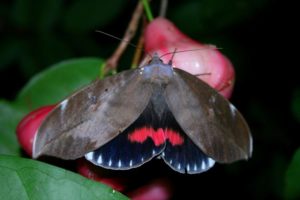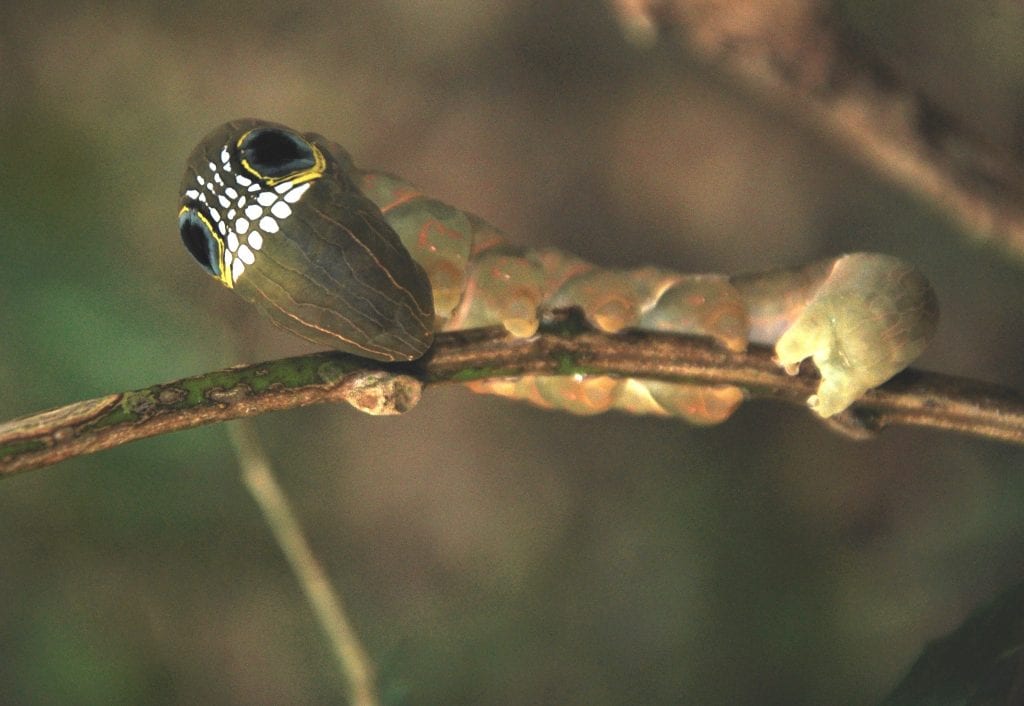National Parks
Southern Pink Underwing Moth
There is a plant out there hidden amongst South-East Queensland’s national parks that you may not have heard of. It’s called Carronia (not Carona!) multisepalea, or the Carronia vine. While it’s indistinct little flowers, straggly vine-like growth and elbow-shaped leaf-stalks are not immediately awe-inspiring, the plant plays a critical role in the life-cycle of something far more dazzling, Phyllodes imperialis subsp. smithersi or in easier language, the Southern pink underwing moth. Both the Carronia vine and the pink underwing moth occur in Springbrook National Park and Lamington National Park.

This moth grows to an impressive 16cm across (wing-tip to wing-tip) and is roughly the same size as a fully-grown female Richmond birdwing butterfly (Ornithoptera richmondia). As well as its size, the moth has another striking feature, its colouring. The front-wings are deep brown with incredible markings that make the wings look just like a dead leaf. It is extremely well camouflaged when it sits motionless, wings closed, during daylight hours. If the moth gets startled, it reveals its hind-wings which are blotched with fluorescent pink!
The caterpillars are one of the world’s most exotic and eccentric-looking. The caterpillar grows to an impressive size (10-12cm long) and has an opal-like colouring of brown, beige, aqua and pink. Like most caterpillars, its head is relatively small and indistinct, however, right behind the head are a couple of fleshy segments that have white ‘tooth-like’ markings and feature two large blue false eyes with prominent black pupils. When you give this guy a fright, be prepared for a shock of your own. When startled the larva lunges forward folding its real head inside the fleshy upper segments engorging its false teeth and eyes. The caterpillar has evolved these markings to keep its otherwise tasty body safe from birds and other predators.
Like all moth and butterfly caterpillars, the Southern pink underwing moth larva is fussy when it comes to food. It has developed a special relationship with the carronia vine, which is the sole plant species that its larvae can eat. Unfortunately, as our native rainforests have been cleared and replaced with cities and farms, the carronia vine has also disappeared, and the moth with it.
This is not a story that is unique to these two species. So what can we do to help reverse this decline in the carronia vine and the Southern pink underwing moth?
Natura Pacific are working with Native Plants Queensland’s Dr Bonni Yee and retired honorary CSIRO fellow Dr Don Sands, to propagate 10,000 carronia vines to repopulate suitable rainforests across South-East Queensland and connecting to our National Parks will be critical to this project. Growing the vine from seed has been a great challenge, consequently, stem cuttings are being used instead. Once grown, male and female carronia vines along with a small syzygium or lillipilli species will be provided to local councils and private landholders within the moth’s native range. The vines will provide the foodplants for the caterpillars and the lillipilli, the food for the adults, which like to suck the sugars from damaged and decaying rainforest fruits.
The aim is establish healthy, genetically-vigorous male and female vines along with fruiting lillipillis to increase potential breeding spots for the moth. Ultimately, the hope is to replicate the huge success of the Richmond birdwing butterfly and vine project nurtured by Dr Don Sands throughout the past 20 years.
To register your interest in planting the vines on your property please email the project coordinator mark.runkovski@natura-pacific.com.


